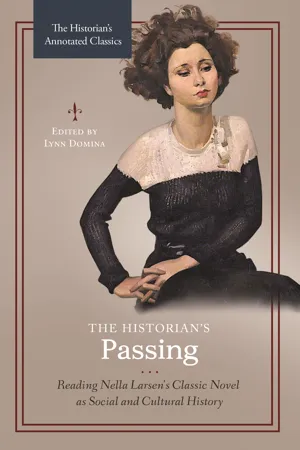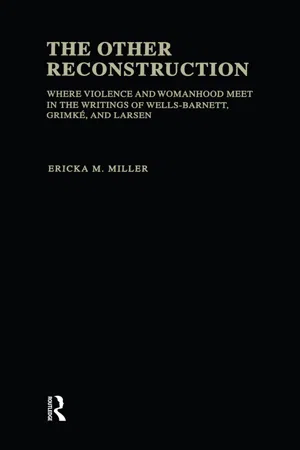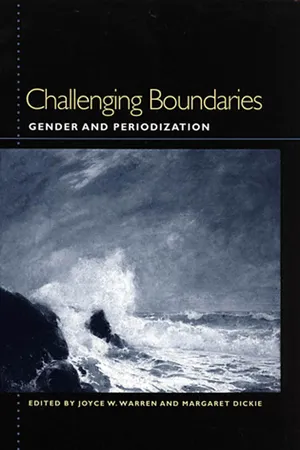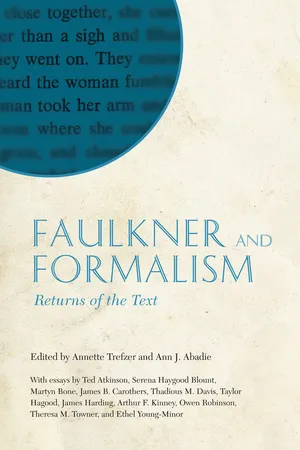History
Nella Larsen
Nella Larsen was an influential African American writer of the Harlem Renaissance in the 1920s. She is best known for her novels "Quicksand" and "Passing," which explore themes of racial identity and the challenges faced by biracial individuals in a segregated society. Larsen's work is celebrated for its nuanced portrayal of race, class, and gender in early 20th century America.
Written by Perlego with AI-assistance
Related key terms
1 of 5
9 Key excerpts on "Nella Larsen"
- eBook - ePub
The Jazz Age
A Historical Exploration of Literature
- Linda De Roche(Author)
- 2015(Publication Date)
- Greenwood(Publisher)
In fact, racially motivated violence continued throughout the era. Nevertheless, this flourishing of African American arts introduced new voices and new forms and established a pathway to integration into the nation’s cultural heritage. It also raised important issues about race and racial identity for both blacks and whites. Many African American writers would explore them in their poetry, fiction, and drama, among them Nella Larsen in her provocative novel Passing. About Nella Larsen: A Life on the Color Line When Nella Larsen died on March 30, 1964, at the age of seventy-two, few would have suspected that one of the most significant female voices of the Harlem Renaissance had just been silenced. Many assumed that she had died years before. After publishing two well-received novels, Quicksand (1928) and Passing (1929), and a few short stories during the Jazz Age, however, the novelist had slipped silently into literary obscurity, working primarily as a nurse in New York City until her death. In the 1970s, however, as a new generation of scholars sought to rescue the literary works of women and writers of color, Larsen’s novels were rediscovered and reissued for a new audience interested now in the issues of gender, racial, and class identity that are central to her fiction. They were central to her life as well and perhaps account for her obscurity in death. Born in Chicago, Illinois, on April 13, 1891, Nellie Walker was the child of mixed-race parents. Her father, Peter Walker, was an Afro-Caribbean immigrant from the Danish West Indies who quickly disappeared from her life; her mother, Marie Hansen, a Danish immigrant, was a seamstress and domestic worker who married a fellow Danish immigrant, Peter Larsen, several years later. Nellie, a mixed-race child, soon had a white half-sister and assumed her stepfather’s surname. From her beginnings, in other words, race complicated Larsen’s identity - eBook - ePub
African American Literature
An Encyclopedia for Students
- Hans Ostrom, J. David Macey Jr., Hans Ostrom, J. David Macey Jr.(Authors)
- 2019(Publication Date)
- Greenwood(Publisher)
LLarsen, Nella (1891–1964)Novelist. Known for her work during the Harlem Renaissance, Larsen wrote about the politically charged subjects of racial identity and White privilege as well as the social roles and expectations for women in the 1920s. She obscured many of the details of her personal life, which may have been a statement about her privacy or the desire to move between both Black and White cultures. Born in Chicago, Illinois, to Mary Hanson Walker, who was Danish, and Peter Walker, who was of West Indian descent, Larsen would not know family life with her parents. Shortly after her birth, her parents separated and her mother married another Dane, Peter Larsen. Soon after Larsen’s mother remarried, she gave birth to another daughter. Many scholars speculate that the young Nella may have had a difficult childhood and a tense relationship with her stepfather, since she was the only “non-White” member of her immediate family. This struggle to identify herself as either Black or White, and the social constrictions placed on African Americans, would become a recurring theme throughout her life and her writing.Regardless of these tensions, Larsen received an excellent education. She attended public schools in Chicago until 1907, when her stepfather enrolled her in Fisk University Normal School. She then attended Fisk University in Nashville, Tennessee, from 1909 to 1910. Then she decided to finish her education in Denmark, and audited classes at the University of Copenhagen for two years. Upon returning to the United States, she attended nursing school at Lincoln Hospital in New York City. After graduating from nursing school, she spent a brief time at the Tuskegee Institute, helping to train other nurses and serving as head nurse at John Andrew Memorial Hospital. However, Larsen soon returned to New York, and from 1916 to 1921, she worked as a nurse for both Lincoln Hospital and the Department of Health. During this time, she met and married a physicist, Elmer S. Imes. - eBook - PDF
The Historian's Passing
Reading Nella Larsen's Classic Novel as Social and Cultural History
- Lynn Domina(Author)
- 2018(Publication Date)
- Praeger(Publisher)
4 Yet this trait also offers commentary on perceptions of the American racial divide in the early 20th century—there’s black and there’s white, and never the twain shall meet. In response to Quicksand, Larsen was honored with a Bronze Award for Literature from the Harmon Foundation, established to celebrate liter- ary accomplishment by African American writers (Kaplan 536). Her ac- complishment was also recognized by the NAACP, and her public status rose as she began to be perceived as Nella Larsen the writer rather than as the wife of noted physicist Elmer Imes or any of her other identities. Her relationship with other writers—many of whom anticipated her continuing success as a major voice in the Harlem Renaissance, or the “New Negro” movement as it had been called—continued to develop. By the time Quicksand appeared in print, Larsen was well into the draft of her next novel, Passing. Her second novel, significantly shorter than Quicksand and as much a novella as a novel, also addresses racial themes, though its approach is very different from Quicksand’s. Passing features two central characters, Irene Redfield and Clare Kendry. 3. See Chandler (25); Showalter (77–78). 4. Showalter (77–78). The Historian’s Passing 12 Contemporaneous reviewers as well as more recent critics disagree about which of these characters is the protagonist or whether they both function as equally central characters. 5 Although the novel is narrated in the third person, Irene serves as the central consciousness; her perceptions are sometimes unreliable, which contributes to much of the novel’s ambiguity surrounding several plot points. Irene and Clare grew up in the same Chi- cago neighborhood, and both are light enough to pass as white. Irene passes only occasionally and for convenience, such as to be served at an elegant restaurant. Initially through no fault of her own, Clare passes per- manently, marrying a white man whose prejudice against black people is brutal. - John K. Young, George B. Hutchinson(Authors)
- 2013(Publication Date)
- University of Michigan Press(Publisher)
Te next signifcant edition of the novel is Deborah E. McDowell’s, for the American Women Writers Series of Rutgers University Press (1987). Tis book set of a new phase in Larsen’s reception, publishing Larsen’s two novels together at the very moment black feminist criticism and black women’s fction were gaining new footholds in the academy and the publishing industry. In her infuential introduction, Deborah E. McDowell argued that the novels were not really about biracial identity or passing but rather about black female psychology and sexuality. As if to signal this new understanding, the cover of this book features a well- known photograph by the Harlem photographer James Van der Zee of three well-dressed, unmistakably African American women of the 1920s strolling joyously, arm in arm, down a broad Harlem sidewalk. Celebrat-ing three evidently middle-class black women’s friendship, the photo-graph has little in common with either of Larsen’s novels. On the back cover, one fnds two blurbs, one by Alice Walker and one representing african american literature 59 from the Women’s Studies International Forum, the latter reading, “A tantalizing mix of moral fable and sensuous colorful narrative, exploring female sexuality and racial solidarity.” A brief description of the contents reads, “Nella Larsen’s novels Quicksand (1928) and Passing (1929) docu-ment the historical realities of Harlem in the 1920s and shed a bright light on the social world of the black bourgeoisie. Te novels’ greatest appeal and achievement, however, is not sociological, but psychological. As noted in the editor’s comprehensive introduction, Larsen takes the theme of psychic dualism, so popular in Harlem Renaissance fction, to a higher and more complex level, displaying a sophisticated understand-ing and penetrating analysis of black female psychology.” Deborah E.- eBook - ePub
The Historian's Passing
Reading Nella Larsen's Classic Novel as Social and Cultural History
- Lynn Domina(Author)
- 2018(Publication Date)
- Praeger(Publisher)
CHAPTER 1 The Many Lives of Nella LarsenWhen Nella Larsen was born there in 1891, Chicago was a thriving industrial city, its neighborhoods marked by ethnic divisions among European immigrants who had arrived during the previous generations. It was poised to begin absorbing another wave of immigrants who would arrive from Eastern and Southern Europe between the last decades of the 19th century and World War I as well as African Americans who would move north during the Great Migration beginning in 1910. Larsen’s own family mirrored some of these American ethnic characteristics. Her mother, Mary Hansen Walker Larsen, was a white woman from Denmark, where many relatives remained. Her father, Peter Walker, was a black man who had been born in the Caribbean. Nella Larsen’s identity as a mixed-race person situated within her specific mixed-race family would profoundly affect her experience of the 20th century, for as W. E. B. Du Bois so famously prophesied, “The problem of the Twentieth Century is the problem of the color line” (The Souls xxxi).As is true of many individuals who achieve some degree of fame but whose lives are otherwise obscure, Nella Larsen presents challenges to her biographers, especially when those biographers are working long after their subject’s death and the deaths of most of her acquaintances. Larsen’s most prominent biographers are Thadious M. Davis, author of Nella Larsen: Novelist of the Harlem Renaissance; A Woman’s Life Unveiled, published in 1994, 30 years after Larsen’s death, and George Hutchinson, who published In Search of Nella Larsen: A Biography of the Color Line a little over a decade later.1 - eBook - ePub
The Other Reconstruction
Where Violence and Womanhood Meet in the Writings of Ida B. Wells-Barnett, Angelina Weld Grimke, and Nella Larsen
- Ericka M. Miller(Author)
- 2020(Publication Date)
- Taylor & Francis(Publisher)
In the early twentieth century, the new Negro became the icon of “the erotic, the exotic, and the innocent,” states duCille, the “ancient, primal and primitive… panacea for an overindustrialized society dying from an acute case of modernity.” Citing Sigmund Freud’s theories linking darker races to low-level civilization, uninhibited sexuality, and the mysterious female sexual self, as well as Sander Gilman’s work on the black female body as a centuries-old metaphor for excessive sexuality, duCille maps the racially feminized iconography of primitivism (73). 9 At the core of Nella Larsen’s Quicksand and Passing lies a struggle with this very problem: How does one avoid fixity in the pursuit of liberation? An examination of these novels, however, might benefit from some understanding of the author and her philosophy of art. In his biography of the writer, Thadious Davis approaches a characterization of Larsen the artist through her position in the “art versus propaganda” debate between black artists and intellectuals of the mid-to-late twenties, a point of contention so designated by other Renaissance scholars as well. Davis states that unlike those such as W. E. B. DuBois and Sterling Brown who believed that the truth of Negro experience in the United States was necessarily propaganda, Larsen insisted upon distancing her art from racial appeals. On this issue she was closer to those such as Alain Locke, who believed that the aesthetic should be the author’s first concern and that truth would necessarily follow. Though Larsen wrote about Negro life, albeit as experienced by the thin slice of the population known as the black elite, she sought appreciation of her work for the craft it demonstrated, not for any particular political statement it made - eBook - ePub
Surviving the Crossing
(Im)migration, Ethnicity, and Gender in Willa Cather, Gertrude Stein, and Nella Larsen
- Jessica Rabin(Author)
- 2005(Publication Date)
- Routledge(Publisher)
fiction…. On the other hand, the dominant can withhold such possibilities and place upon the minority subject a set of de-limited sites of representation within the supposedly open field of the universal” (193). It was precisely these limitations that Larsen sought to free herself from through her fiction.QUICKSAND: THE HEART OF AN IMMENSE DARKNESS
Larsen defined herself as a writer—” Nella Larsen, novelist” (Davis 2)—and sought to situate herself as part of a literary tradition. It is interesting, therefore, that Gertrude Stein, one of the few writers Larsen actually identifies as a literary mentor, was not yet widely read. Nevertheless, Larsen’s “poor first book” (qtd. in Gallup 216) indeed shows the influence of Stein’s first published text, though that influence may not manifest itself overtly. As Davis suggests, Larsen’s “embedding of Stein’s ‘Melanctha’ into the narrative gestures toward a gendered search for voice and actualization” (275). Thus it is on the underlying level of subtext that Larsen most clearly takes lessons from Stein. The protagonists of both “Melanctha” and Quicksand share salient (and more obvious) features, however. To begin with, both Melanctha Herbert and Helga Crane are American mulattas with a light-skinned (in Helga’s case, white) mother and a dark-skinned, unscrupulous absentee father. Both women lose their mothers at a relatively young age, and neither seems to find the loss particularly wrenching. Parents provide little emotional support and offer meager financial resources. Consequently, “all her life long, [Melanctha] loved and wanted good, kind and considerate people” (TL 72), and “all her life Helga Crane had loved and longed for nice things” (Q 6). These seemingly modest goals prove difficult to attain, as Melanctha undercuts her own efforts towards security and advancement by “always losing what she had in wanting all the things she saw” (TL 50), while Helga battles a “ruthless force, a quality within herself, which was frustrating her, had always frustrated her, kept her from getting the things she had wanted. Still wanted” (11). Both protagonists also have trouble creating a correspondence between inner and outer realities. Thus, Melanctha’s inability “to tell a story wholly” (TL 57) finds an analog in Helga’s difficulty in being honest with those around her. Helga resorts to telling “angry half-truths” (26) to Dr. Anderson, and she heeds Mrs. Hayes-Rore’s advice to conceal her white origins by saying only that her mother is dead and leaving curious minds to “fill in the gaps to suit [themselves]” (41). Perhaps in part due to their communication difficulties, Melanctha and Helga are often seen as detached from other people and from any specific landscape. Melanctha is characterized as an urban wanderer, while Helga responds to the necessity of seeking employment in Chicago by wandering (27, 32). She is offered the opportunity to make money by knowing white and black men (as Melanctha does with “the different men, white ones and blacks” [TL 84]), “but the price of the money was too dear” (Q 34). Because of their detachment from people, Melanctha and Helga are puzzling to their acquaintances. Melanctha is “mysterious” (TL 50, 61), like her mother was before her (TL - eBook - PDF
Challenging Boundaries
Gender and Periodization
- Joyce Warren, Margaret Dickie(Authors)
- 2012(Publication Date)
- University of Georgia Press(Publisher)
As mother and son begin to move away, a big, burly white man, a watchman or keeper or something tells the children that they cannot stay there: No niggers in there. The effect on the war-torn son is disastrous, mani-festing itself in his inability to complete the performance of the musical com-position until one day he forces himself to do so, causing his own death. The story, which in one way celebrates the access that socially disfranchised black Americans have to a European cultural tradition by way of their inalienable rights as Americans, is a fascinating study of race that examines the beautiful and idyllic South as the seat of violent racism .that silences and suffocates aes-thetic sensibilities and artistic achievements. Both Coleman and Graham fit into a dyadic black women's literary tradition of the Harlem Renaissance which is epitomized by Zora Neale Hurston, on the one hand, and both Jessie Redmon Fauset and Nella Larsen, on the other. The one is firmly rooted in African American folk ways and myths, while the other more readily explores the possibilities of combining European and African forms and themes. Slackened Caprice, in particular, lends itself to a reading of Nella Larsen's Quicksand, for her novel interrogates the problematics of the New Negro's return to the southern landscape after experiencing northern and European modernity. Contemporary readers are familiar with Helga Crane and her search for an elusive racial identity, which leads her south to her demise. Graham's eccentric young man of Slackened Caprice, though positioned in the South during the story, has experienced the racial contradictions of both Europe and America but has chosen to use his southern locale as a way of attempting emotional, racial, and aesthetic reconciliation. The results for both protagonists are devastating. BLACK WOMEN WRITERS OF THE HARLEM RENAISSANCE : 103 One final word. - eBook - PDF
Faulkner and Yoknapatawpha Series
Returns of the Text
- Annette Trefzer, Ann J. Abadie, Annette Trefzer, Ann J. Abadie(Authors)
- 2012(Publication Date)
- University Press of Mississippi(Publisher)
144 Intertextual Geographies of Migration and Biracial Identity: Light in August and Nella Larsen’s Quicksand Martyn Bone This essay provides a comparative analysis of William Faulkner’s Light in August ( 1932 ) and Nella Larsen’s Quicksand ( 1928 ). My starting point is that Faulkner and Larsen have more in common than one might assume if reading them only as exemplars of the Southern Renaissance and Har-lem Renaissance respectively. More specifically, reading Faulkner along-side Larsen may help to resituate Faulkner’s “Southern” writing about race in wider national and transnational contexts. In Dirt and Desire: Reconstructing Southern Women’s Writin g, 1930– 1990, Patricia Yaeger makes the parenthetical observation that “Nella Larsen’s reflections on the South in Quicksand ( 1928 ) and Passing ( 1929 ) offer still wider reference points for gendered remappings of the New South’s racial coordinates.” 1 Yaeger does not pursue the point, but Quick-sand remaps Southern “racial coordinates” via a narrative geography that is structured around multiple migrations. Quicksand ’s protagonist Helga Crane travels not only between the South and the North, but also back and forth across the Atlantic between New York and Copenhagen. During these migrations, Helga also crosses the color line of U.S. racial ideology. Helga’s biracial identity and transnational triple consciousness (Negro, American, and Danish) challenge the rigid definitions of race that so restrict her life in the United States. My claim is that Joe Christ-mas’s peregrinations across regional, national, and racial boundaries in Light in August can usefully be read alongside Helga Crane’s. At least since Alfred Kazin’s 1958 essay “The Stillness of Light in August ,” Faulkner critics have been alert to the intersecting racial and spatial dimensions of the novel.
Index pages curate the most relevant extracts from our library of academic textbooks. They’ve been created using an in-house natural language model (NLM), each adding context and meaning to key research topics.








